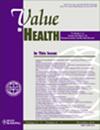Unpaid Caring and Health-Related Quality of Life: Longitudinal Analysis of Understanding Society (the UK Household Longitudinal Survey)
IF 4.9
2区 医学
Q1 ECONOMICS
引用次数: 0
Abstract
Objectives
Decision models for economic evaluation are increasingly including health-related quality of life (HRQoL) for informal/unpaid carers, but these estimates often come from poor quality data and typically rely on cross-sectional analysis. We aimed to identify within-person effects using longitudinal analysis of 13 waves of Understanding Society (the UK Household Longitudinal Survey).
Methods
We analyzed data for coresident carer and care-recipient dyads, where the carer reported “looking after or giving special help to” the care recipient in any of the 13 waves. We used fixed-effects models to study the effects of caring for the care recipient (the “caregiving” effect) using volume of care (hours per week) and continuous duration of caregiving (years) and caring about the care recipient (the “family” effect) using the care recipient’s HRQoL on the carer’s HRQoL. HRQoL was measured using the Short Form 6 Dimension, calculated from the Short Form 12.
Results
We found consistent evidence for the family effect: improving care recipient’s HRQoL by 0.1 would improve carer’s HRQoL by approximately 0.012. We also consistently found evidence of a small but statistically significant decrement to carer’s HRQoL for each additional year of caring. These findings were robust to scenario analyses. Evidence for the relationship between volume of care and carer’s HRQoL was less clear.
Conclusions
We propose that our estimates can be used to populate economic models to predict changes in carers’ HRQoL over time and allow disutilities to be estimated separately for the family and caregiving effect.
无偿照料和与取暖相关的生活质量:对 "理解社会"(英国家庭纵向调查)的纵向分析。
目的:用于经济评估的决策模型越来越多地包括非正式/无偿照护者的健康相关生活质量(HRQoL),但这些估算通常来自质量较差的数据,而且通常依赖于横截面分析。我们的目标是通过对 13 次 "了解社会"(英国家庭纵向调查)的纵向分析来确定人内效应:我们分析了同住照护者和受照护者二元组的数据,其中照护者在 13 次调查中的任何一次中都报告了 "照护或给予特别帮助 "受照护者的情况。我们使用固定效应模型来研究照顾受照顾者("照顾 "效应)对照顾者的影响(使用照顾量(每周小时)和连续照顾时间(年));以及照顾受照顾者("家庭 "效应)对照顾者的影响(使用受照顾者的 HRQoL)。HRQoL 采用简表 6 维(SF-6D)进行测量,由 SF-12 计算得出:我们发现了家庭效应的一致证据:护理对象的 HRQoL 提高 0.1 将使护理者的 HRQoL 提高约 0.012。我们还一致发现,照顾者每多照顾一年,其 HRQoL 就会略有下降,但在统计学上具有显著意义。这些发现在情景分析中都是可靠的。护理量与照护者 HRQoL 之间关系的证据不太明确:我们建议将我们的估算结果用于经济模型,以预测照护者的 HRQoL 随时间的变化,并分别估算家庭效应和照护效应的损失。
本文章由计算机程序翻译,如有差异,请以英文原文为准。
求助全文
约1分钟内获得全文
求助全文
来源期刊

Value in Health
医学-卫生保健
CiteScore
6.90
自引率
6.70%
发文量
3064
审稿时长
3-8 weeks
期刊介绍:
Value in Health contains original research articles for pharmacoeconomics, health economics, and outcomes research (clinical, economic, and patient-reported outcomes/preference-based research), as well as conceptual and health policy articles that provide valuable information for health care decision-makers as well as the research community. As the official journal of ISPOR, Value in Health provides a forum for researchers, as well as health care decision-makers to translate outcomes research into health care decisions.
 求助内容:
求助内容: 应助结果提醒方式:
应助结果提醒方式:


